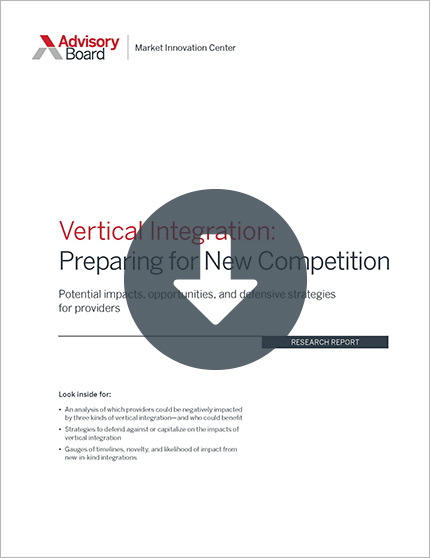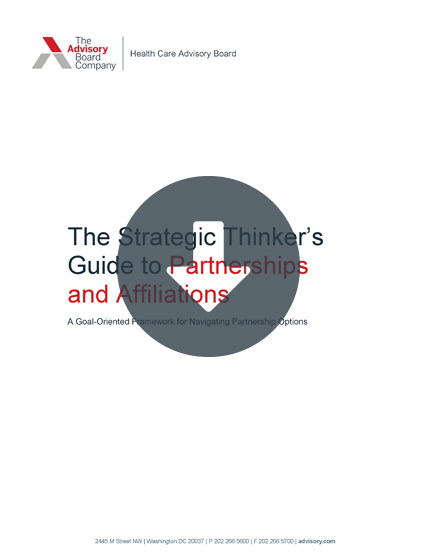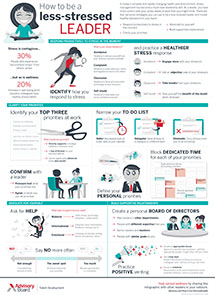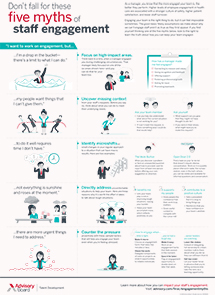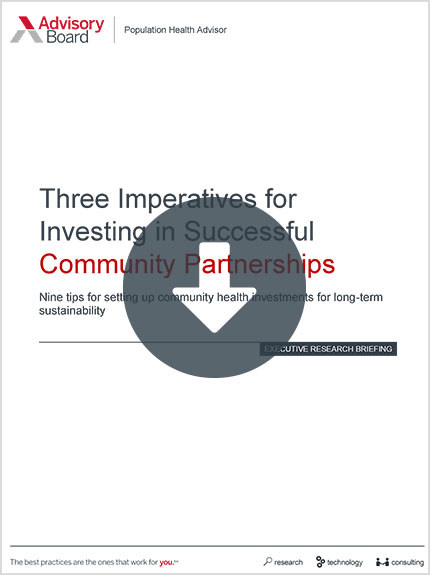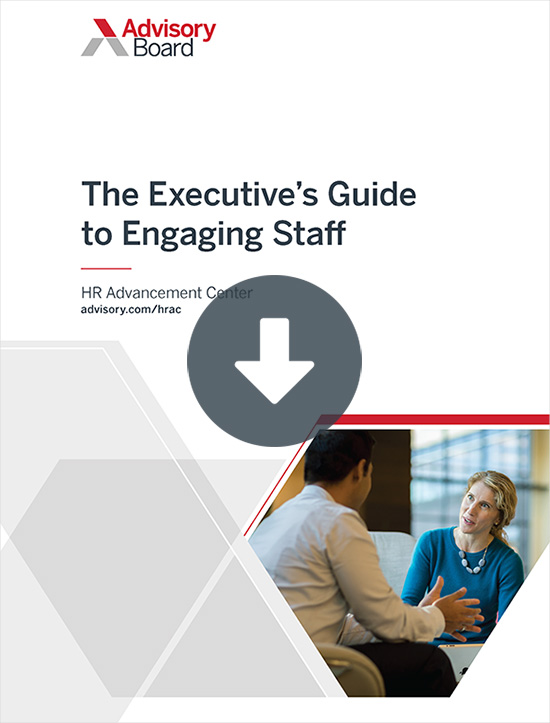Auto logout in seconds.
Continue LogoutWelcome to the "Lessons from the C-suite" series, featuring Advisory Board President Eric Larsen's conversations with the most influential leaders in health care.
In this edition, CommonSpirit Health CEOs Lloyd Dean and Kevin Lofton talk about how they moved the Dignity Health-CHI merger from "what if" to "let's go," why they don't consider themselves "co-CEOs," and how they plan to "set the trend" for health care in America.
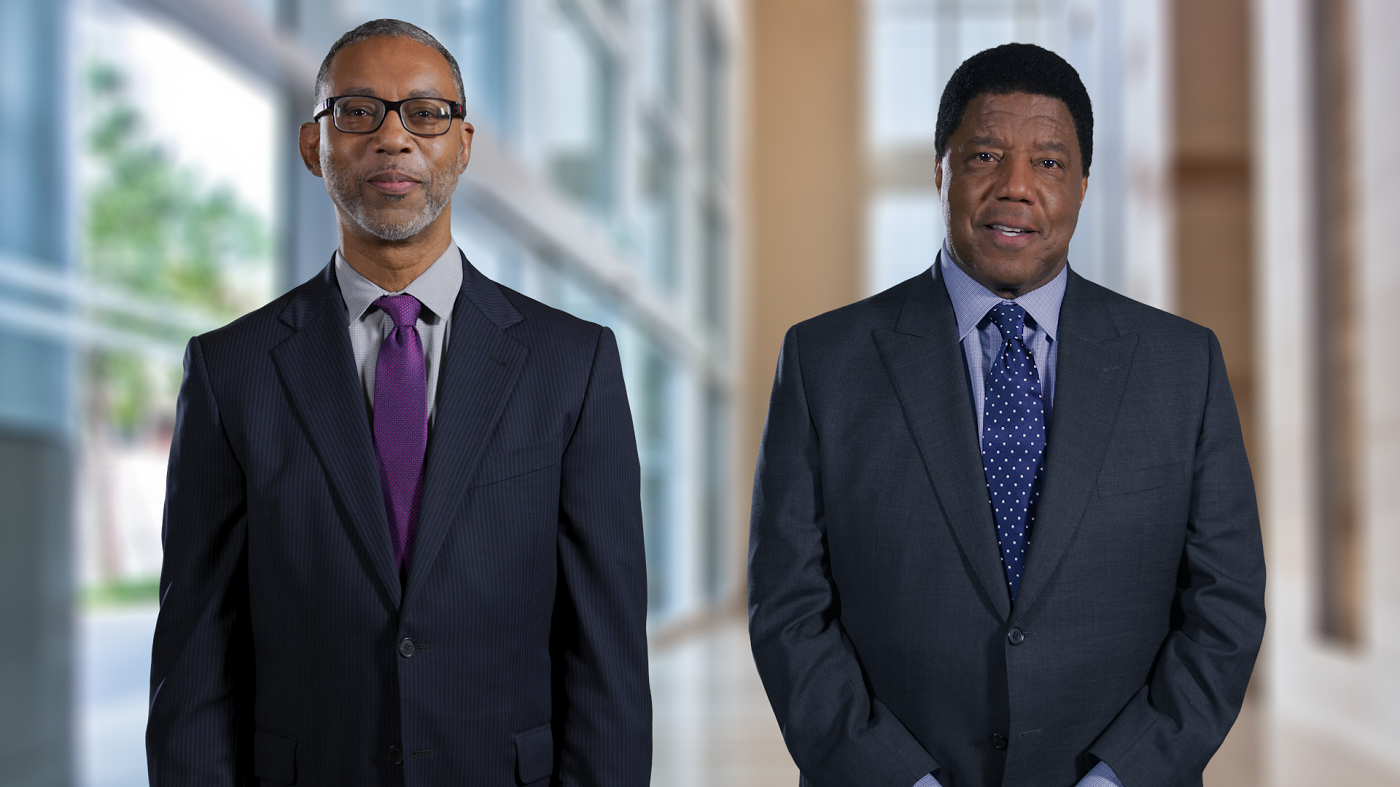
Lloyd Dean and Kevin Lofton, CEOs of CommonSpirit Health
Question: First off, gentlemen, congratulations on this historic, $29 billion merger. It was a protracted process, as we know, and I have to imagine the recent completion of the deal has released a ton of energy and excitement. Before we dive into the discussion, I'd like to first ask about your new name—CommonSpirit Health. I believe the name relates back to a Bible verse: "Now to each one the manifestation of the Spirit is given for the common good." How did you arrive there?
Kevin Lofton: We wanted something that was contemporary and visionary. So we talked about the common good, how we want to serve as many people as possible, and how we wanted to make sure it also connected to our faith-based heritage. So we feel it is a perfect name.
Lloyd Dean: It speaks to who we are and what we represent.
Question: Let's talk about the sheer size of the enterprise for a moment, which is unprecedented—21 states, 142 hospitals, 700 sites of care, and 150,000 employees, including 25,000 physicians. So tell me, what's the aspiration here? Why did two established, mission-driven organizations come together as the nation's largest nonprofit?
Dean: Let me start by saying that we didn't do this for scale or size. Both CHI and Dignity had size and scale in their own right. So while we understood what the quantitative scale would be, the reason we came together was because we wanted to have an impact on health care in this country. We want to use this aggregation of scale and exchange of best practices to create a different kind of clinical enterprise to take health care to the communities—when they want it, where they want it, and how they want it.
Lofton: As Lloyd said, it's not size for the sake of size—but we also know that size and scale is the means to an end. Integration at this scale gives us the synergies we need to do the work we're envisioning. Because when we look at the diversity and size of the markets and communities we serve, with between 20% and 25% of the U.S. population within accessible distance of a CommonSpirit facility, we feel that the way we do business will set the trend for the country. And that's what the vision is all about—we're going to set the trend. If we can do it here, if we can do it in Los Angeles, if we can do it in Grand Island, Nebraska, then that's America.
And we're not looking for incremental change, either—one plus one can't equal two or even three; it needs to equal far more than that. So while CHI or Dignity might have achieved a lot independently, we've created a certain newness by coming together as CommonSpirit Health rather than as "Dignity acquiring CHI" or "CHI acquiring Dignity." And that newness lets us capture the creative juices in a way that lets you say not, "This is how we've always done it," but, "We don't care how we've always done it. What's the best way to do it going forward?" And that scale gives us some room; not every new thing we do has to be a home run.
Dignity and CHI, the building blocks of CommonSpirit Health
Q: Each legacy organization – CHI and Dignity – brings complementary strengths to this union, so let me ask: Where do you think those complementarities exist? It's too easy to ask about your own organization's strengths, so let me ask you each about your counterpart. Lloyd, looking across the aisle at CHI, what assets and capabilities caught your attention?
Dean: There were a couple of things. Number one, we were aligned on mission, and that's the foundation of our innovation and motivation. Number two, we also were very attracted to CHI's diverse service lines, including its nationally recognized work for in-home health and older adults—things we were seeking, but which we didn't have. Number three, we had worked together for more than two years on precision medicine, so we knew that the character and journey of the organization was complimentary to ours.
Upcoming webconferences
Tuesday, May 7
How health systems can re-ignite growth
Thursday, May 23
The 4 must-do steps to grow your service lines
Tuesday, June 11
How to win the race for ambulatory surgery market share
Tuesday, June 18
9 ways to realize pharmacy’s full value
Finally, when you look at our geographies, while Dignity has a great presence in metropolitan areas, CHI serves diverse communities large and small. And our goal has always been to be able to serve communities—the totality of them—regardless of the demographics. So we were very attracted to their governance desire to serve larger populations while creating something that allows individual patients to say, "They are making a difference."
Q: And Kevin? Same question to you, this time about Dignity's strengths.
Lofton: Some of the things would be, quite honestly, the inverse: Dignity is in more large urban populations. And as we move toward population health and being responsible for the entire person, we liked what Dignity exhibited in the California markets around taking care of the entire person.
We also felt that there were key areas relating to community health where we overlapped. Dignity has placed an emphasis on addressing violence and human trafficking in their communities, and that's been a focus for CHI too. And the same is true with programs each system has that look at homelessness, affordable housing, and other social needs.
Q: Lloyd, Dignity was a pioneer in building non-traditional alliances, partly because of who you are organizationally in your DNA, and partly because of your proximity to Silicon Valley. Your collaborations with Town Hall Ventures, Propeller Health, Google, Apple, and others come to mind. Now that you have a substantially larger platform, I have to think that your ambitions here are similarly enlarged.
Dean: Yes. We're looking at innovation and technology from the same premise, which is that despite our scale, we can't do everything or be everything in a community—there are companies out there that have capabilities and skill sets we need to better serve patients and communities. So it is from that launching pad that we look at technology. And those partnerships you mentioned are a part of that.
I'd say that one of the things that legacy CHI and legacy Dignity Health did extremely well, and one of the ways in which many people define us, has been our recognition of the power of partnerships, and our willingness to embrace them. In fact, the only reason we're here today is because our organizations started in a partnership for precision in medicine.
Q: Your last comment segues to my next question: Would you talk a bit about the origin story? So many of these alliances have really rich and fun stories. Hackensack Meridian's Bob Garrett and John Lloyd, for instance—and this might be an apocryphal story, but it's awesome either way—say they came up with their merger in a swim-up bar in Cabo.
Lofton: I wish we could say that.
Dean: Not that we haven't been in some bars.
Lofton: But we didn't swim up.
Q: I'm assuming it's much more dignified.
Lofton: Unfortunately, it isn't that.
Dean: No, it's not that dignified.
Lofton: Both of us were talking to different organizations all the time, but we'd know within the first five minutes that there wasn't a connection there. There was a great connection for Lloyd and me—so much so, actually, that our vision was much bigger than what our boards were initially willing to accept. Our boards said, "Why don't you see if you could do something together as proof-in-concept, see how the culture is, things like that?" So we came up with the Precision Medicine Alliance (PMA), launching in 2016 with our initial focus on cancer care.
And after that, we went back to our respective boards and said, "Here's the proof that the culture is there." Because we had done a cultural assessment with 56,000 employees from both companies, and we found that eight of the top 10 things employees said they liked about their current organization and would like to carry into the new organization were the same for both CHI and Dignity employees. Similarly, seven of the top 10 things employees said they'd like to change about their organization were the same. So the compatibility was there—and at that point, it switched from a "what if" conversation to a "let's go."
Dean: And because I don't like that the swim story beats our story, I should say that after we started PMA, Kevin and I ran into each other outside a CHA meeting. We sat down at a little table and said, "You know, maybe there's an opportunity to do more right here." We were both focused on growth—again, not for growth's sake, because there's a graveyard full of companies that have just tried to get bigger. Rather, we felt that by having gotten better, we had an opportunity to get bigger.
So this merger really came out of that conversation. Both of us are dreamers, so we started asking, "What if we were able to create this? What would this mean for communities? For patients? For Catholic health care? For addressing health inequities? What kind of example could we set for the nation?" That's how it worked. And then we just stair-stepped it with our boards and our chairs and our governance.
Office of the CEO
Q: I want to unpack the co-CEO architecture, because there's a statistic you may know on this—publicly traded companies that announce co-CEOships outperform the S&P 500 by an average of 2.5% in the year following the announcement.
Dean: Oh, that's not where I thought you were going, Eric. I thought you were going to cite the statistic about how on average, at least in the United States, most of those arrangements have a three- to five-year lifespan before it goes down for a whole host of reasons. But we'll use yours. I like that one better.
Q: Happy to help. So tell me, how did you two hammer this out?
Lofton: First of all, internally, we don't use the word "co-," because to us, that implies we have to decide everything together; we call it the Office of the CEO.
That said, there are two defined areas—strategy and integration—where we actually are "co-." We make those decisions together because Lloyd's bringing his experience and knowledge from Dignity Health, and I'm bringing in my experience and knowledge from CHI. And we'll also work together on the really important things, such as when we picked the executive leadership team.
But beyond that, Lloyd's clearly defined over X areas in the organization, and I'm clearly defined over Y areas. We'll collaborate, and we'll talk through things in a way that you might say is "co-," but there's a clear division of ultimate responsibility. And that made sense for our boards, which wanted to retain both of us for the organization—the organization doesn't want Lloyd to be the COO or me to be the COO because that's not who we are at this point in time, but it also doesn't want to get bogged down with the idea that Lloyd and I have to get together for every decision. But for the selection of the executive leadership team, we did that together. We literally sat in a room with every single pair of people who had the common position and discussed their roles. Those types of really important things we do together.
Dean: I think an attractive attribute of both Office of the CEO and co-CEO models is that they recognize the complexity of health care. They recognize that putting and bringing together two organizations of our size and scale is quite a job, and that having that institutional knowledge and leadership from both organizations will facilitate integration and give us efficiencies in terms of knowledge, leadership, and being able to make necessary change—and to me, that was the motivation for our governance.
Q: And how did you two delineate the non-shared responsibilities? Because when I was talking to Bob and John, they basically said, "Well, we sat down to dinner, we wrote down all the stuff we each wanted to do…"
Lofton: Well, that's close to how we did things. Since we were each doing the whole thing for our respective organizations, we knew that either one of us could do either side for the combined organization.
Dean: That's right; we just decided. I mean, there was more science to it than that, in that we looked at where each organization was, what our individual passions were, and where we thought we could each have the most impact in creating CommonSpirit Health.
Lofton: And this process helped illuminate something for me I didn't see upfront, which is that by having the two of us in the Office of the CEO, more people and functions can report directly to the CEO than is possible with a single CEO. So we have a couple of functions that wouldn't normally report directly to the CEO, but now can do so.
Looking ahead
Q: I'd like to telescope out a bit and ask you more broadly about the state of Catholic health care in the United States. I think we can agree there's a lot of dynamism in this space right now—your two organizations coming together, a changing of the guard imminent at both Ascension and Trinity, the new Bon Secours Mercy Health being formed. What's your take on the "state of the union" here, and on CommonSpirit's role within a sector that represents nearly one out of every five U.S. hospitals?
Lofton: I don't know that there's any single answer because the factors are so diverse. I think a big part of it is consolidation—right now, we're really down to the big four, so I'm not sure we'll continue to see that kind of consolidation at that level, although we've still got the smaller mergers, like Bon Secours Mercy.
But CommonSpirit Health has a platform where hospitals and organizations that are not Catholic can fit into our structure. So CommonSpirit Health will continue that kind of innovation, coming up with models and structures that we think both Catholic and other than Catholic organizations will be interested in.
Now, Catholic hospitals have traditionally made up about 17% of all U.S. hospitals, so as a sector, it's not going to go away. But in the future, we don't even want to count that number; we want to be able to talk about how the ministries are making a difference in the communities we serve.
Dean: And I would add that health care in the United States is at an inflection point. You had the ACA and its various modifications, but we still have 20 million people who do not have any formalized method of health care access. And one of the stabilizing forces in this nation, going back 100 years, has been Catholic health care; it's one of the safety nets for many communities, particularly for people with few resources and for people of color. Today, Catholic providers are more likely to support community health programs for the most vulnerable patients, or to provide Medicaid services, or to offer service lines like trauma and mental health that might not be as profitable but are urgently needed.
Re-ignite the growth engine: 3-part report series
So Catholic health care is more important today than ever, even as the challenges for health care and for Catholic health care are numerous, whether financial, political, technology-related, what have you. But we believe Catholic health care is a vital part of the country's ecosystem of health care, and we're proud that CommonSpirit Health will be in a position to help ensure that that legacy lives on.
Q: Lloyd, you spoke earlier of the "graveyard" of organizations that chose to pursue growth for growth's sake, and I'd like to explore that. Recent history has been unkind to some non-contiguous, horizontal mergers on both the for-profit and nonprofit side, such as CHS and Tenet. What have you learned from observing some of these well-documented case studies?
Dean: One of the conclusions I draw is that health care is local; once you lose that focus, you are on a path to some of these issues. Two, the way companies or ministries structure themselves is key; the decisions around what you want to be and how you want to serve people in communities is a factor in whether you'll be successful. If you're going to be a fully integrated operating company, that puts you on one path. If you're going to be a holding company, that puts you on another path.
Lastly, you have to figure out what ties the organization together—what's the vision, the mission, the values, the operating principle? Some organizations became more infatuated with their size and scale and missed those fundamentals. But if you can check those boxes every day, I think you're going to be okay.
Q: CommonSpirit, as we mentioned, now encompasses 21 states, and many more MSAs within those states … the heterogeneity of your markets reflects the richness, variety, and frankly the challenges of America itself. Obviously, this presents unique opportunities and potential pitfalls for the new organization.
Lofton: Yes that's exactly right. As Lloyd said, the starting point for us is understanding each market and how we fit into that market. What we know is that there are many different ways to serve our communities—and our communities often have very different needs. Our capabilities range from large medical centers to small critical access hospitals to mobile clinics. And we need to determine what will best serve our communities.
Because, simply put, how well you're going to do is determined by how relevant you are in the community. This boils down to: Are people coming to our facilities? If not, what would be the better configuration and how can we best add value to this community? It may not be in the form of a hospital. It may be an outpatient facility, an ASC, a community clinic, or something else entirely—like transitional care for homeless patients or more affordable housing.
Dean: And I think there's a key difference between health care and some other sectors. Ford Motor Company, for example, can put a plant in every community, make all those plants look alike, hire the right personnel, and churn out cars—a Ford is a Ford is a Ford. But that's vastly different in health care. Are there some non-optional, standard capabilities, values, and best practices we'll have as part of CommonSpirit Health? Yes, but every community is unique. And that gets back to our goals here: We don't just want to be in a community, we want to be of the community—and that's a vast difference.
Lofton: I'd add also that when we assessed our merger, our investigative team did a side-by-side comparison of us against similar organizations in our respective markets. And, in what was a key building block for our merger, the team found that most of CHI and Dignity markets were further advanced in terms of the changes coming in health care and the way health care will operate in the future. In comparison, some other comparable organizations that might be doing better right now are in markets where the pain point is still coming—we've already passed that pain point.
Q: With health care spend rocketing from $3.6 trillion to $6 trillion by 2027, there's this hyper-scrutiny on total cost of care. We're going to have to be pretty introspective and innovative about where and how we rationalize costs. So if it's not proprietary to share, what's your cost-transformation target? Or are you still discerning that?
Lofton: It's proprietary because we're still working to refine the number, but we're projecting it out over a four-year period. And there's a dual perspective here: While the business plan we provided for the board doesn't show us getting everything in year one—because, quite honestly, we've added costs to put this together before we'll see certain benefits—we also can't wait a year or two for people to start to see at least some of the benefits of us coming together.
So we've identified 10 or 12 "Bright Spots." These are areas at the core level of the operation that we can point to as successes in 90, 120, and 150 days—such as home care, where we're already converting legacy Dignity home care markets into legacy CHI's home health company. But again, while we'll be able to demonstrate some immediate, short-term benefits, the big numbers are going to come from the course of those four years.
Dean: And I'd add that the number in and of itself is a limited measure of how we're doing. To me, the more important thing is what drives that number. For us, we think innovation and use of technology within CommonSpirit Health and with our partners should help drive down cost. And why would we want to drive down cost? We want to drive down costs to ensure patients can attain the health care they need while also being able to access resources that excessive health care costs would otherwise prevent, such as education and housing. We don't want people having to make the choice between medications and buying clothes for their children—and we know that there's a gap there. And it's not a one-time game; we have to think continually, every day and every year, about how we can be more efficient. It's not just about the number.
Wrapping up
Q: As we draw to a close, I'd like to ask each of you to reflect on your respective career paths. I say affectionately that the two of you have already had a few of the toughest jobs out there. Kevin, you were a taxi driver in the Bronx, a FedEx shipment loader, and, at one point, you ran the seventh-busiest ED in the country. Lloyd, you worked as a teacher—perhaps not as dangerous as Kevin's navigating the potholes of New York City, but certainly hard work—and later as a pharma sales rep. So with those professional pedigrees, this new gig should be a breeze.
As you two embark on what may be the most remarkable chapter in your careers, what are you most grateful for when you look back?
Lofton: It's the realization that you can't do it alone. And that understanding, really, means I can honestly say that the most fulfilling part of my career is going to be working with Lloyd to lead this organization. Lloyd is one of the great leaders in the United States, and I think that together, the sum of the Office of the CEO will allow for even more to be accomplished in our organization. We're both comfortable with who we are as individuals, so we'll be able to collaborate. Which isn't to say we'll agree on every point, but we'll reach conclusions together without trying to outdo the other person or keeping score in terms of, "Well, that one went your way last time."
And even as Lloyd and I lead the organization together, we each know it's going to be a talented group of people across the organization who are really helping us get all that done. And this gets to the core of our shared commitment to leadership, which is the idea that this is a people business—not just the people we serve in the communities, but also the 150,000 associates in our organization. A big part of what we have to do is make sure that the work environment, benefits, and salaries are at a level that make people want to work for CommonSpirit, and ultimately to make sure our associates feel connected to the mission of being a faith-based organization. Put all of that together, and it's a recipe for what we can do.
It's also prophetic for me. I have a great aunt who was a founder of a Franciscan order and my mother literally lived in a convent when she was a teenager. Fortunately, she went in a different direction, otherwise you wouldn't be talking to me here today. My parents were part of the community and had legacies of service. Those connections to the Catholic nuns feels like destiny to me.
Dean: I can't even add to that. That was beautifully said. But on a personal note, I'd say I'm most grateful to be in a position to have an impact on one of the most important elements of human life, and that's health. And I say that because I grew up in an environment where I saw the impact of not having access to health care. So to stand here with Kevin and to use our voice to ensure that people in all communities—people with few resources, people from diverse backgrounds, people living in communities with multi-faceted demographics—won't have to go down that path is an awesome gift.
That's why I love what I do. And while legacy CHI and legacy Dignity Health impacted millions of lives, CommonSpirit Health gives us the possibility of impacting one out of four people in this country and to be a voice for the voiceless. And our Women Religious have given us an opportunity that I could have never dreamed about. If we can leave this world of health and the communities we have the privileg to serve better than we found them, it will be a job well done.
Get more lessons from the C-suite
Check out Eric's recent must-read interviews with top hospital and health system leaders:
Don't call THR a 'hospital system': Inside CEO Barclay Berdan's vision for health care's future
Barclay Berdan, CEO of Texas Health Resources, talks about the ""unprecedented challenge"" he faced just a few months into the job, why he won't call THR a ""hospital system, and how he helped establish the world's largest Blue Zones community—in Fort Worth. Read our interview with Barclay.
'A little bit of a pirate': How Kelby Krabbenhoft built a $6B system—and where he's taking Sanford next
Kelby Krabbenhoft, president and CEO of Sanford Health, talks about the unprecedented CEO-philanthropist partnership behind Sanford's rapid growth, why a successful leader needs to be ""a little bit of a pirate, and the merger that will make Sanford a nearly $6 billion health system. Read our interview with Kelby.
Marc Harrison promised to turn Intermountain into a 'Tesla.' He wasn't kidding.
Marc Harrison, president and CEO of Intermountain Healthcare, talks about Intermountain's recently announced strategic reorganization, previews the launch of a ""virtual hospital"" to better serve rural communities, and shares the surprising worry that keeps him up at night. Read our interview with Marc.
"
Don't miss out on the latest Advisory Board insights
Create your free account to access 1 resource, including the latest research and webinars.
Want access without creating an account?
You have 1 free members-only resource remaining this month.
1 free members-only resources remaining
1 free members-only resources remaining
You've reached your limit of free insights
Become a member to access all of Advisory Board's resources, events, and experts
Never miss out on the latest innovative health care content tailored to you.
Benefits include:
You've reached your limit of free insights
Become a member to access all of Advisory Board's resources, events, and experts
Never miss out on the latest innovative health care content tailored to you.
Benefits include:
This content is available through your Curated Research partnership with Advisory Board. Click on ‘view this resource’ to read the full piece
Email ask@advisory.com to learn more
Click on ‘Become a Member’ to learn about the benefits of a Full-Access partnership with Advisory Board
Never miss out on the latest innovative health care content tailored to you.
Benefits Include:
This is for members only. Learn more.
Click on ‘Become a Member’ to learn about the benefits of a Full-Access partnership with Advisory Board
Never miss out on the latest innovative health care content tailored to you.
